|
Speos Artemidos / Beni Hassan |
last update:
12.12.2009
|
| At Beni Hassan two smaller rock-temples were raised for the lion-headed
goddess Pakhet, the "Goddess of the Mouth of the Wadi" who was locally
worshipped in that area was given the
surname "She who Scratches", Pakhet was also believed to be an
embodiment or an "aspect" of Hathor.
|
| The goddess Pakhet appears on coffin texts, however, her cult is
not attested in the area of Beni Hassan before the New Kingdom. Possibly,
Hatshepsut has honored a local but unimportant goddess with the building of the rock temple
and, thereby, promoted her cult
|
| The larger of the two temples is well-known under the Greek name "Speos Artemidos"
("Grotto of Artemis"; arab. Istabl Antar), since the Greeks identified Pakhet with
their goddess Artemis.
|
|
The rock temple (see photo below) which is aligned to a north-south-axis is located on the east bank of the Nile
near the mouth of a small desert valley (Wadi Batn el-Baqara) which goes off right-angled from the river valley,
about 1.5 km to the south of the necropolis of Beni Hassan. The temple was completely cut out of the
living rock, possibly at the site of an older cult place from the
Middle Kingdom. However, the oldest decorations originate from the times of
Hatshepsut.
|
| Neither the original name nor its date of erection during the
reign of Hatshepsut are known. |
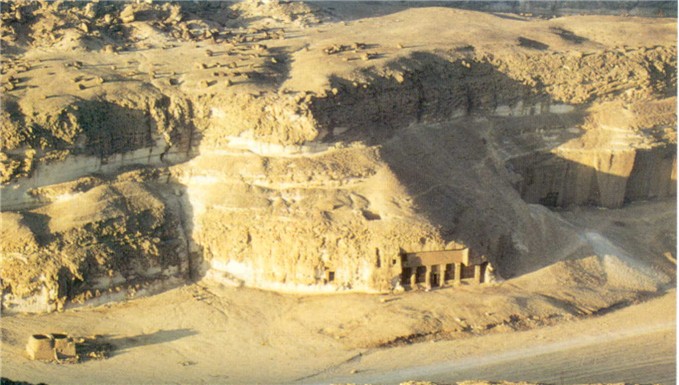
| The Speos Artemidos in the morning light (photo taken from:
Bickel, Chappaz, 1993)
|
|
The temple consists of a pillared transverse hall (pronaos) with a front-length
of about 15 m and a sanctuary behind the hall (see also floor plan above). The
hall itself is formed by a double row of 4 pillars each but only the three
easternmost (left) of the row forming the facade still survive.
|
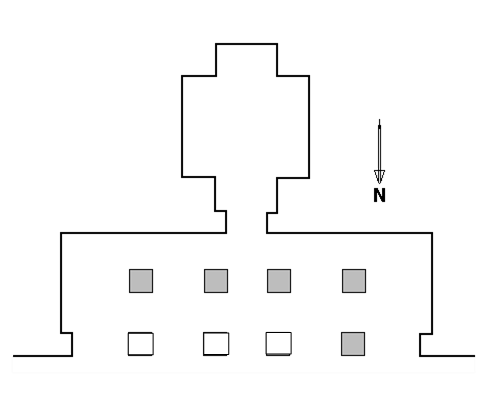
| Floor plan of the "Speos Artemidos" dedicated to Pachet
("Grotto of Artemis") at Beni Hassan; from the totally 8 pillars only three of the first row have survived. |
| The most important part of the
inscriptions of the temple is a text of Hatshepsut (Urk. IV, 383-391) on the
facade above the
entrance. In this text she complained about the damage done during the
reign of the "Asiatics of Auaris" (= Hyksos; which happened 3
generation before her reign but was not forgotten) and reports that
"she has restored what was taken down" - what she did in fact. |
| Astonishingly, her father Thumosis I is not mentioned in this
context. |
|
The first row of pillars
had been prepared on their outer (northern) sides for decoration with Hathor-headed
capitals (Bickel, Chappaz, 1993). The
eastern and western sides
of these pillars show inscriptions and cartouches of Thutmosis III and
Sethi I. The second row of pillars which had not been finished carried
the ceiling of the hall.
|
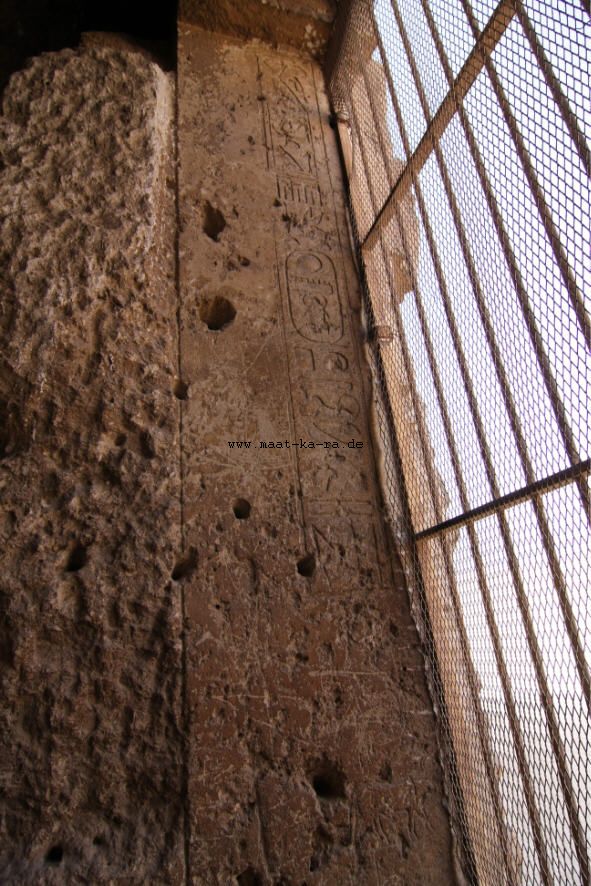
| The eastern side of the 3rd (westernmost) pillar which shows a cartouche of Thutmosis III (photo: W. Ulrich).
All preserved pillars have not been finished on their southern side (as shown
here). |
|
In the portico itself only the south (rear) wall of the hall has been decorated with
scenes and texts originally inscribed for Hatshepsut and subsequently
restored and usurped by Sethi I.
|
| The ceiling of the transverse hall is decorated with
inscriptions and relief which are very worn today and discernible with
great difficulty in some areas. |
| The rear wall of the transverse hall shows on both sides
of the doorway to the sanctuary scenes in which Hatshepsut stands before
of several divinities. The following photo shows the two scenes on the eastern
side of the hall (photo by W. Ulrich). |

| The scene left of the doorway shows Hatshepsut (changed to
Sethi I) kneeling inside the pr-wr and receiving the Khepresh-crown from Amun who is depicted sitting on his
throne. The lion-headed goddess Pakhet-Weret-Hekau with the sun-disk on
her head is depicted facing both, extending her left hand to the head of the
kneeling queen and blessing her (see following photo by W. Ulrich). |

| This scene is shown on the drawing below prepared by L. Chappaz-Pache (Les
Dossiers dŽArcheologie, 1993). The scene has been reworked during the
19. dynasty (now Sethi I is shown kneeling before and turning to Amun)
but the traces allowed the reconstruction of the original picture. |
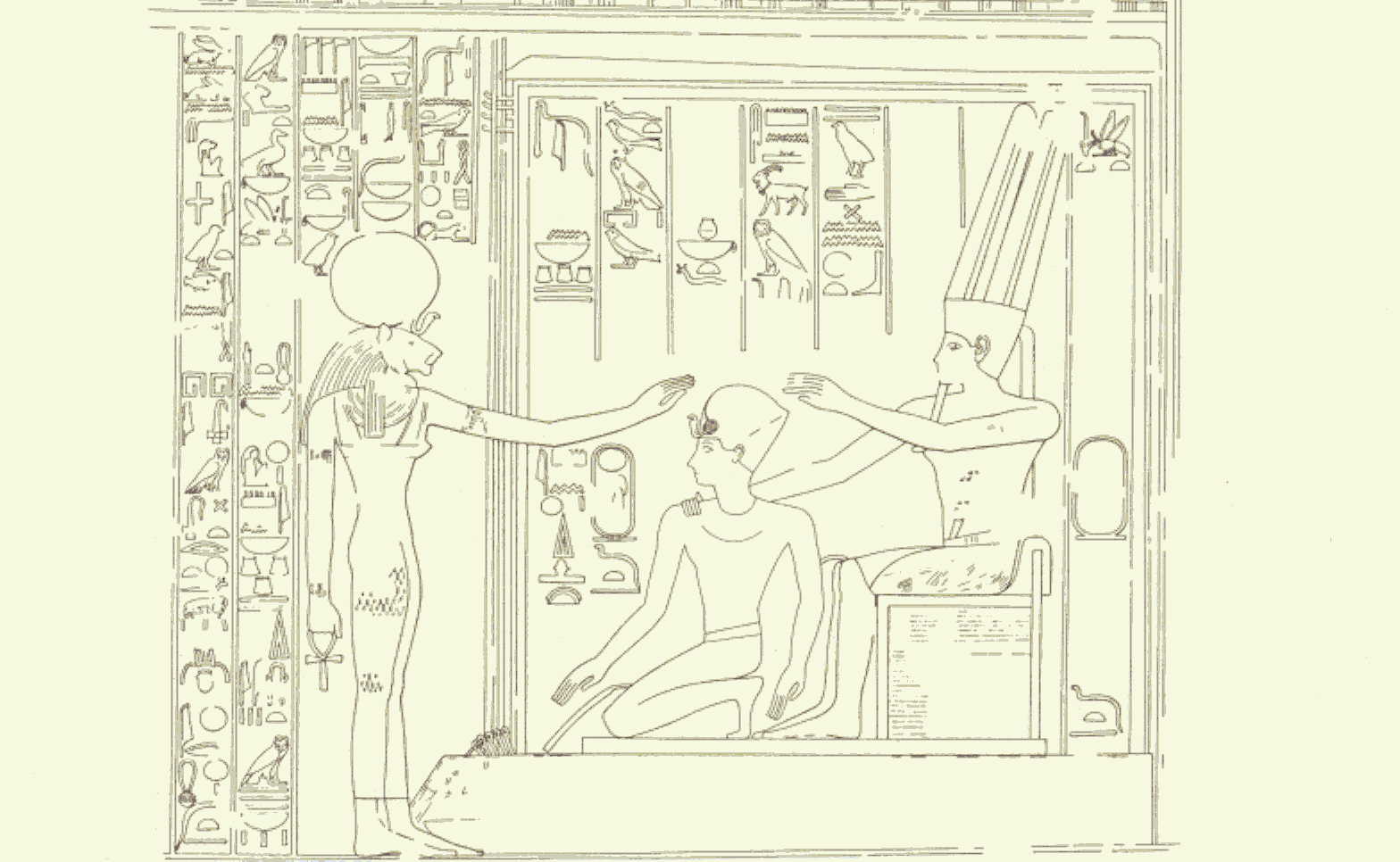
| Among others Fairman and Grdseloff (JEA 33, 1947) have published the
corresponding text of the proclamation of Hatshepsut by Amun (see
below). However, they have tried to give what they believed was the
original version of Hatshepsut - although in this and all other
scenes on the south wall the royal figure is male and all cartouches of Maat-ka-Ra (Hatshepsut) have been
usurped by Men-maat-Ra (Sethi I)
|
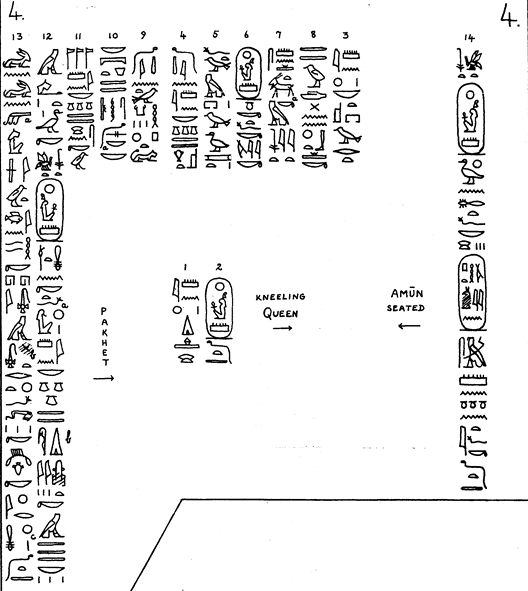
The text of Amun reads:
1 - An offering which Amun-Ra gives at the appearance of
2 - (Maat-ka-Ra), for ever.
3 - Amun-Ra, Lord of the Great Seat
4 - Utterance of Amun-Ra, Lord of the Thrones of the Two Lands, who is on
his great seat
5 - in the Great House (Pr-wr) O my beloved (daughter)
6 - (Maat-ka-Ra), I am thy father
7 - (I) establish (for) thee thy rank in the kingship
8 - of The Two Lands. I have fixed your titulary
|
The text of Pakhet-Weret-Hekau reads:
9 - Utterance of Pakhet-Weret-Hekau
10 - Lady of the Heaven, Mistress of the Two Lands: Seat
thyself [in Pr-wr), O Lord
11 - of the Gods when thou has installed me
12 - on the brow of thy daughter, the King of Upper and Lower Egypt
(Maat-ka-Ra) even as thy father Ra has commanded thee, O Amun, Lord of the Thrones of the Two Lands. I place the
fear of thee in all lands.
13 - I rear myself up between thine eyebrows, my fiery breath being as a fire against thine enemies and thou are glad through me like Ra for ever.
|
The text right behind Amun reads:
14 - Men-maat-Ra, King of Upper and Lower Egypt, Son of Ra of his
body, Lord of the Diadems, Seti-Merenptah, who restores the monument of
his father for ever.
|
| The left side of this wall shows Thot in front of the Ennead
(see following photo by von W. Ulrich). |

| Above the passage two ritual runs before the seated goddess Pakhet
are depicted on the lintel,
on the left (eastern) side a run "Seizing the oar", on the right (western) side a ritual run with vases. |
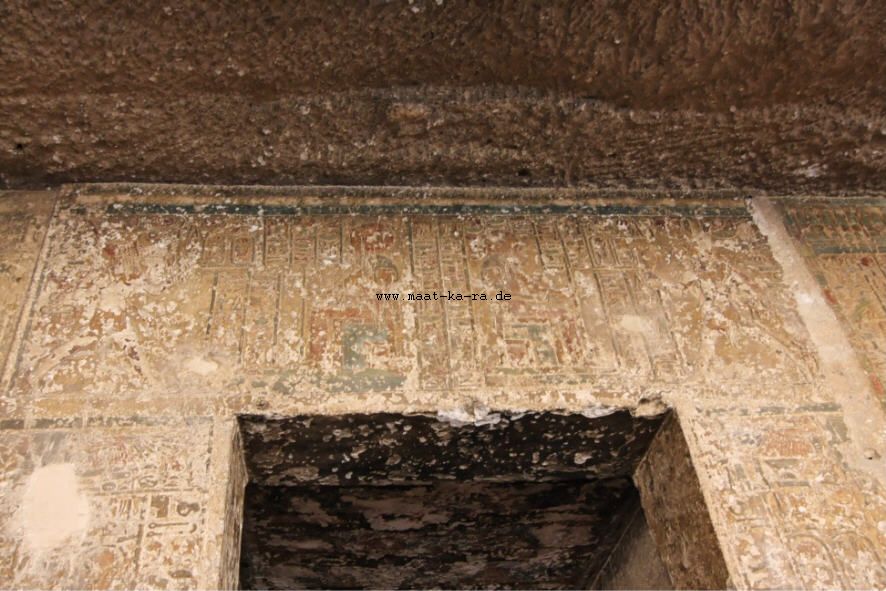
| On both jambs Sethi I is depicted (see below: left jamb; photo
by: W. Ulrich). |
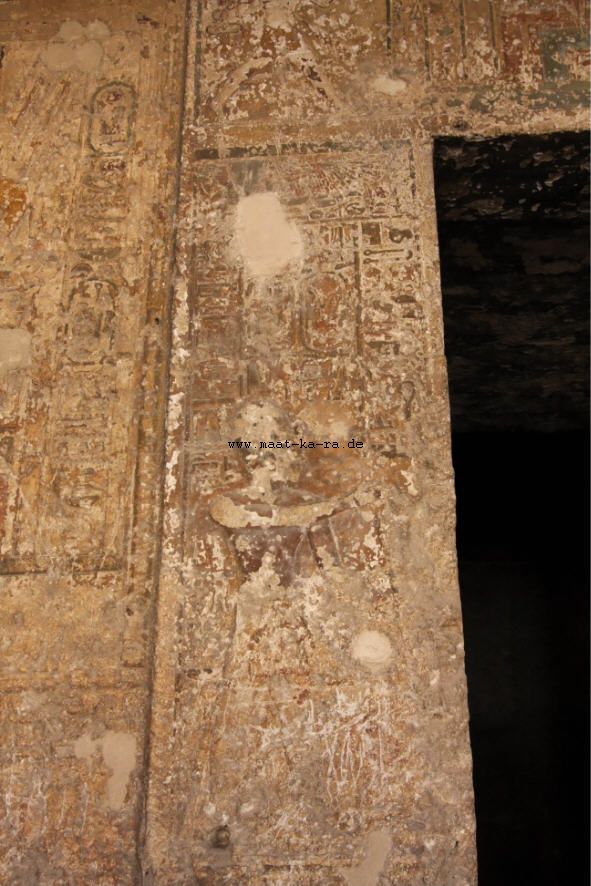
| The western rear wall of the transverse hall shows 3
scenes which all had been usurped by Sethi I. |
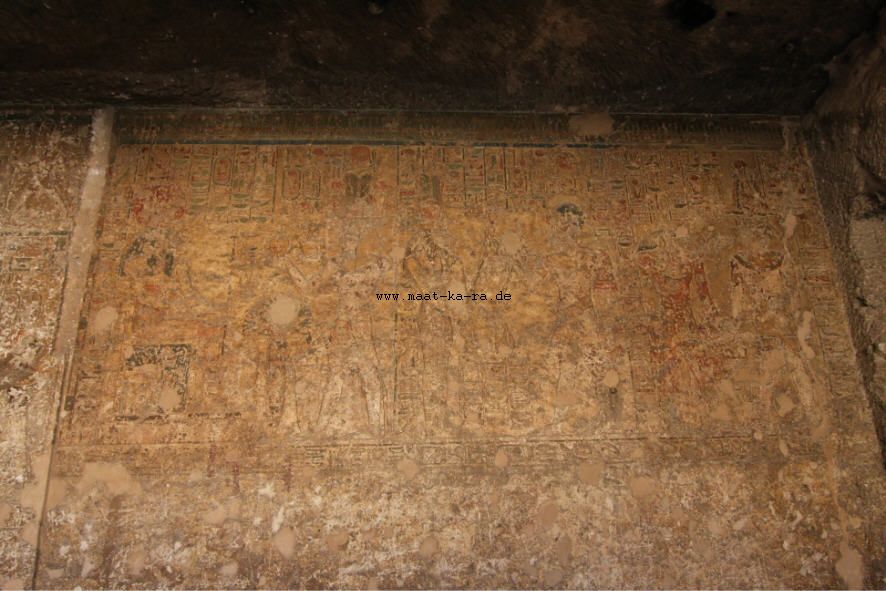
| Survey of the western side of the rear wall of the transverse
hall (photo by: W. Ulrich). |
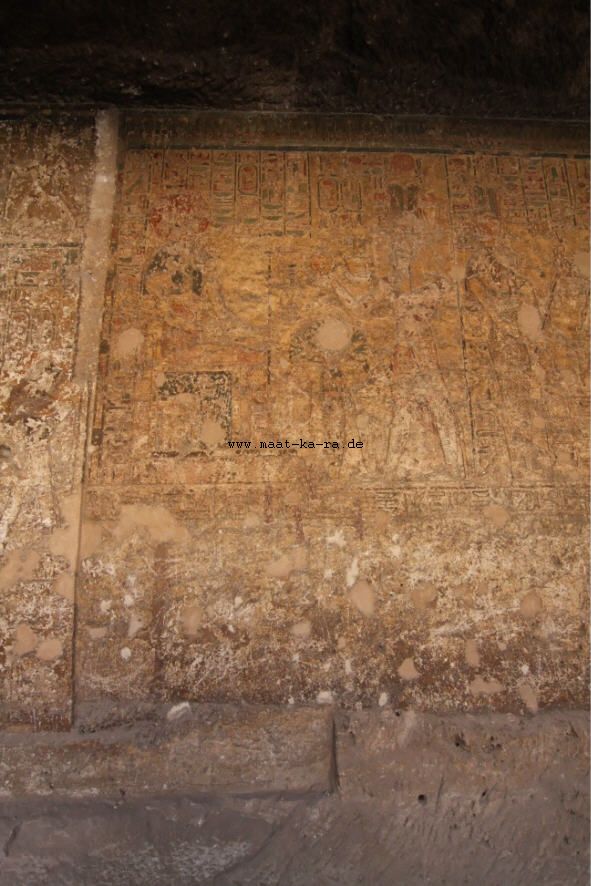
| Left scene: Hatshepsut (usurped by Sethi I) -facing left
- in front of the seated seated goddess Weret-Hekau Pakhet (photo by: W.
Ulrich). |
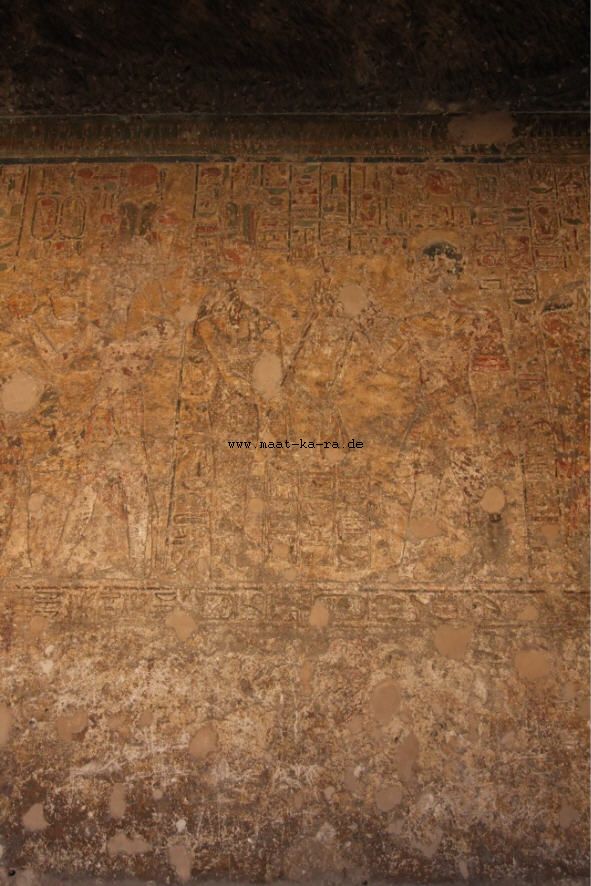
| The scene in the center shows
Hatshepsut (usurped by Sethi I) - facing left - before a goddess with
serpent-scepters (photo by: W. Ulrich). |

| The scene on the right shows
Hatshepsut (usurped by Sethi I) - here she is depicted facing right - before the Thot
(photo by: W. Ulrich).
|
| The sanctuary itself was not decorated in the time of
Hatshepsut. The sanctuary was decorated by Sethi I with his own inscriptions but he left it
incomplete. All together, the Speos Artemidos remained unfinished.
|
|
Interestingly, Fairman and Grdseloff (JEA 33, 1947) reported that they did
not find any traces of cutting out the name of Amun, thus, the Speos
Artemidos was probably neglected or overlooked by the Amarna
iconoclasts. Furthermore, they did not find any traces that the texts of
Hatshepsut had been altered by Thutmosis III although his name appeared
twice on the pillars.
|
| The smaller temple, Speos Batn al-Baqara, became already disfigured during the reign of Thutmosis
III. |
|













